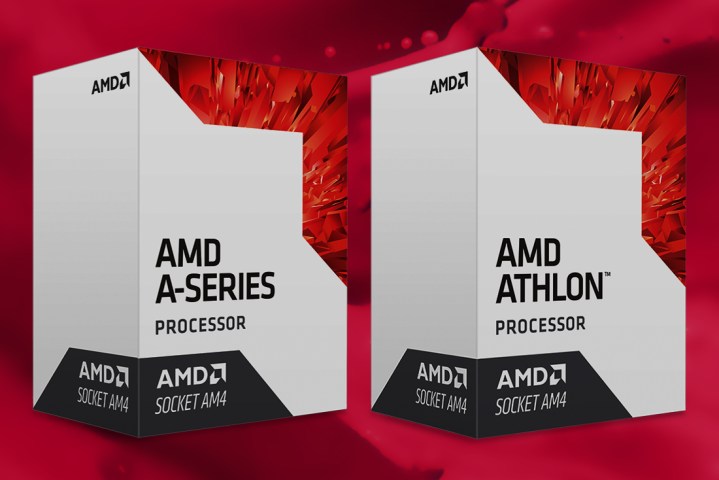
“The introduction of 7th Gen A-series, Athlon X4, and Ryzen 3 processors completes the stable, mature socket AM4 ecosystem, making it the only future-ready platform that scales all the way from entry-level CPUs all the way up to the high-end 8-core/16-thread Ryzen 7 1800X,” AMD said.
Here are the eight publicly available seventh-generation A-Series APUs for the AM4 (PGA 1331) socket:
| CPU Cores |
Base Speed |
Max Speed |
GPU Cores |
GPU Speed |
Power Draw |
|
| A12-9800 | 4 | 3.8GHz | 4.2GHz | 8x Radeon R7 | 1,108MHz | 65 watts |
| A12-9800E | 4 | 3.1GHz | 3.8GHz | 8x Radeon R7 | 900MHz | 35 watts |
| A10-9700 | 4 | 3.5GHz | 3.8GHz | 6x Radeon R7 | 1,026MHz | 65 watts |
| A10-9700E | 4 | 3.0GHz | 3.5GHz | 6x Radeon R7 | 847MHz | 35 watts |
| A8-9600 | 4 | 3.1GHz | 3.4GHz | 6x Radeon R7 | 900MHz | 65 watts |
| A6-9550 | 2 | 3.8GHz | 4.0GHz | 4x Radeon R5 | 800MHz | 35 watts |
| A6-9500 | 2 | 3.5GHz | 3.8GHz | 6x Radeon R5 | 1,029MHz | 65 watts |
| A6-9500E | 2 | 3.0GHz | 3.4GHz | 4x Radeon R5 | 800MHz | 35 watts |
As shown above, these all-in-one processors (SoCs) rely on Radeon R7 (mid-range) and R5 (entry-level) graphics cores, which are based on GPU designs prior to 2016’s “Polaris” architecture, and the current “Vega” design now rolling out to the desktop market. Notice that as the graphics cores break the 1,000MHz (1GHz) speed barrier, the parent chip requires more power from the desktop.
Again, all eight APUs (short for Accelerated Processing Unit) slip nicely into AMD’s AM4 socket (seat) on motherboards. They are compatible with the B350 chipset in the mainstream market, the A320 chipset for the entry-level market, and the X300, B300, and A300 chipsets for small form factor PCs.
Note that AMD also provides seventh-generation “Bristol Ridge” APUs for notebooks too although they are exclusive to original equipment manufacturers. These include the A10-9600P, the A10-9630P, the A12-9700P, and ten others. AMD sells “Pro” all-in-one chips as well.
Now here are the three seventh-generation Athlon X4 processors made available on Thursday:
| Cores | Threads | Base Speed |
Max Speed |
L2 Cache |
Power Draw |
|
| Athlon X4 970 | 4 | 4 | 3.8GHz | 4.0GHz | 2MB | 65 watts |
| Athlon X4 950 | 4 | 4 | 3.5GHz | 3.8GHz | 2MB | 65 watts |
| Athlon X4 940 | 4 | 4 | 3.2GHz | 3.6GHz | 2MB | 65 watts |
With these graphics-free processors, the 950 and 940 models actually have a power draw between 45 watts and 65 watts. Otherwise, they slip into the same AM4 socket used by AMD’s seventh-generation APUs. They presumably work with the same set of motherboard chipsets, as well.
According to AMD, these three processors provide “true” quad-core power, making them capable of handling popular online games based on DirectX 12 and Vulkan. What would be interesting to see is how they stack up against AMD’s two new Ryzen 3 desktop processors in benchmarks. Ryzen-branded processors are based on the company’s latest “Zen” CPU architecture.
At the time this article went live, the publicly available A-Series APUs and Athlon X4 processors were not listed on Amazon and Newegg, so stay tuned for pricing and actual availability.



